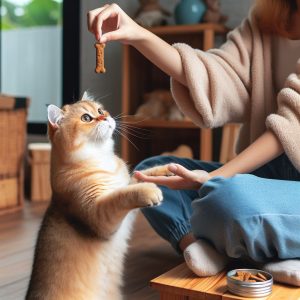As a loving cat owner, you may occasionally find puddles of undigested cat food scattered around the house. Understandably, this discovery leads you to immediately question – is my cat secretly sick? Should I rush to the emergency vet?
Yet paradoxically, you notice your cat appears completely normal otherwise. They’re energetically pouncing around and devouring meals with their characteristic zeal. So why is a seemingly healthy cat throwing up their food?
Let’s dive deeper into the complex feline digestive system to understand this mystifying phenomenon.
An In-Depth Look at the Delicate Feline Digestive Tract
The typical house cat prowling around your home has a gastrointestinal anatomy surprisingly similar to humans. However, some key differences make cats far more prone to vomiting than their hominid cohabitants.
The Esophagus – Built to Regurgitate
Cats have a short, narrow esophagus that connects the throat to the stomach. Importantly, the feline esophagus is structured to facilitate effortless regurgitation of undigested food.
This is because the esophagus contains powerful muscular walls lined by mucus-secreting tissue. When the cat’s stomach becomes irritated, these esophageal muscles vigorously contract in sequence, rapidly reversing the food’s direction back upwards through the throat, ejecting out through the mouth.
So cats can readily vomit up food contents before they move further through the digestive tract.
The Stomach – Low Acidity
A cat’s stomach is small and designed to stretch to accommodate large meals, especially for big hunters like lions and tigers.
However, the feline stomach has lower acidity compared to humans and many other mammals. The gastric juices don’t break down food as efficiently.
So cat food passes into the intestinal tract still in relatively large chunks or pieces, rather than a liquid chyme consistency. This predisposes kitties to vomiting up undigested food.
The Intestines – Short and Fast-Moving
Cats have a very short small intestine compared to their body size. This means food has a rapid transit time, leaving less opportunity for complete nutrient absorption.
The gastrointestinal tract is only around 3-4x the body length in cats, compared to 8-10x in humans.
So cat food passes quickly into the colon within about 8 hours of eating. The faster transit provides less time for thorough digestion, making vomiting more likely.
Key Takeaway
The feline GI anatomy and physiology favors regurgitation of undigested food compared to humans and dogs. But why does this happen so readily? Let’s explore common culprits.
7 Reasons Why Cats Throw Up After Eating
A variety of relatively benign factors can cause a cat to vomit up their food, even while appearing healthy otherwise. Here are some of the most common causes of vomiting soon after meals:
1. Inhaling Food Too Quickly
Cats are notorious for wolfing down meals within seconds. This leaves insufficient time for proper chewing and initial digestion within the mouth and stomach.
Large intact chunks of kibble or meat can irritate the stomach lining. This local irritation triggers those powerful esophageal muscles to push the food back up almost immediately in an attempt to eject the irritant.
Tip: Investing in a puzzle feeder or specially designed cat slow feeder bowl can help pace your kitty, preventing greediness and indigestion.
2. Hacking Up Hairballs
As meticulous groomers, cats are prone to ingesting a lot of fur while self-cleaning. This fur often binds together within the stomach, forming tightly packed masses called trichobezoars or hairballs.
As hairballs grow in size from continuous grooming, they cause irritation and obstruction within the gastric cavity, preventing smooth passage of food. This leads to vomiting shortly after meals.
Tip: Regular brushing and administration of commercial hairball relief supplements can help tackle hairballs prophylactically.
3. Dietary Indiscretion
Our furry felines are infamous for eating anything and everything they can get their paws on – houseplants, rubber bands, plastic, sewing needles – you name it!
Ingesting such unusual non-food items, aka dietary indiscretion, can understandably upset the delicate balance of a cat’s digestive system.
Foreign objects cause irritation and interfere with smooth peristalsis. So the body’s natural response is to eject the irritant by vomiting.
Tip: Keep potentially hazardous household objects safely away from your cat’s reach to avoid temptation and dietary mishaps.
4. Abrupt Diet Change
Sudden changes in food, especially switches between wet canned food and dry kibble, can disrupt your kitty’s gastric equilibrium.
A cat’s sensitive stomach needs time to adjust to significant changes in food texture, moisture content, and ingredient composition. An abrupt switch can overwhelm the stomach.
Tip: Slowly transition between diets over 5-7 days, gradually changing the ratios of new to old food.
5. Motion Sickness
Some cats are inherently prone to nausea and dizziness during car travel or playtime zoomies.
The motion disturbs their sense of balance and equilibrium. This stimulates the brain’s vomiting reflex in an attempt to stabilize the body.
Tip: Opt for anti-nausea medication about 1 hour before any car trips. Also ensure ample breaks during high energy play to avoid over-stimulation.
6. Stress and Anxiety
Emotional issues like introducing a new pet, moving homes, loud noises, or owner absence can manifest physically in cats due to the gut-brain connection.
Stress and anxiety causes the release of hormones that can interfere with gastric mobility and trigger nausea. Vomiting provides momentary physical relief from the emotional turmoil.
Tip: Minimize stressful scenarios for your kitty whenever possible. Try calming supplements. Discuss anti-anxiety medication with your vet if needed.
7. Intestinal Foreign Bodies or Obstructions
Cats sometimes ingest and swallow foreign material like dental floss, cloth, rubber bands, buttons or children’s toys.
These items can cause internal obstructions,preventing smooth passage and digestion of food. Vomiting is the body’s way of trying to clear the obstruction.
Tip: Seek prompt veterinary care if an intestinal obstruction is suspected for evaluation and treatment.
Clearly, a variety of relatively innocuous factors – from hairballs and stress to abrupt food changes – can cause vomiting in cats who otherwise appear perfectly normal and healthy.
But how can you discern when it warrants medical evaluation? Let’s discuss vomiting red flags.
Vomiting Triggers Requiring Veterinary Assessment
Occasional vomiting itself is not necessarily concerning, especially in a seemingly healthy cat. However, please contact your vet promptly if you notice:
- Frequent vomiting, especially more than 2-3 episodes in 24 hours
- Vomiting undigested food regularly, particularly persisting beyond 2-3 weeks
- Presence of blood in the vomit, giving it a red or coffee ground appearance
- Signs of lethargy, diarrhea, constipation, or markedly decreased appetite
- Visible weight loss from persistent vomiting and inadequate caloric intake
- Behavioral signs of abdominal pain and discomfort – vocalizing, crouching posture, sensitive belly
- Vomiting that worsens or continues despite home treatment and diet changes
Such scenarios can indicate an underlying chronic health issue causing frequent vomiting warranting veterinary investigation.
Potential medical causes include:
- Kidney, liver or pancreatic disease
- Gastrointestinal blockages or cancers
- Inflammatory bowel disease (IBD)
- Food allergies or intolerances
- Gastrointestinal bacterial, viral or parasitic infections
- Metabolic disorders like hyperthyroidism
- And more!
Your vet will perform a thorough physical examination and recommend necessary diagnostic tests to pinpoint the root cause of vomiting.
Diagnostic approaches may include:
- Complete blood count and serum chemistry panel
- Urinalysis
- Fecal examination for parasites
- Abdominal imaging – xrays, ultrasound
- Endoscopy
- Biopsies of the stomach and intestines
Once an accurate diagnosis is reached, targeted treatment can be initiated to resolve vomiting and address underlying medical issues.
Preventing Repeat Vomiting Episodes
While the occasional vomit isn’t concerning in an otherwise healthy cat, you can take proactive steps to minimize recurrences:
- Feed smaller, more frequent meals instead of large portions
- Invest in puzzle feeders and activity toys to slow your cat’s eating pace
- Gradually transition between diets over 7-10 days
- Daily brushing to control swallowed hair and hairballs
- Avoid unnecessary stressors and utilize calming supplements
- Ensure easy access to clean, fresh water at all times
- Follow regular deworming and parasite prevention
- Bring your cat in for annual wellness veterinary checkups
Monitor any vomiting episodes closely even if your cat seems fine otherwise. Seek prompt vet advice if vomiting persists beyond 2-3 days or your cat seems lethargic. Act quickly for the best outcome!
When to Visit the Emergency Vet Immediately
While occasional vomiting may not be a major concern, head to emergency veterinary care promptly if your cat exhibits:
- Continuous vomiting lasting over 6-12 hours
- Repeated projectile vomiting across multiple days
- Vomiting up blood or coffee-ground like material
- Prolonged diarrhea occurring alongside frequent vomiting
- Signs of dehydration – dry gums, sunken eyes, weakness
- Difficulty breathing, distended abdomen, or crying in pain while vomiting
- Collapsing episodes or seizure-like muscle spasms
- Evidence of toxin ingestion – vomiting after licking chemicals
- Shock symptoms – rapid heart rate, pale gums, unresponsiveness
Such scenarios can indicate severely disrupted digestion from blockages, poisoning, internal damage and more. They require intensive veterinary monitoring and treatment to prevent deterioration.
In summary, occasional vomiting in cats may not always be a major medical concern if kitty is otherwise playful and eating/drinking normally. Follow some basic diet and lifestyle changes to minimize episodes.
However, if vomiting persists beyond 2-3 days or is accompanied by other concerning symptoms, quickly seek veterinary assessment for targeted diagnosis and treatment. Thorough monitoring of your cat’s health is key to their wellbeing.



